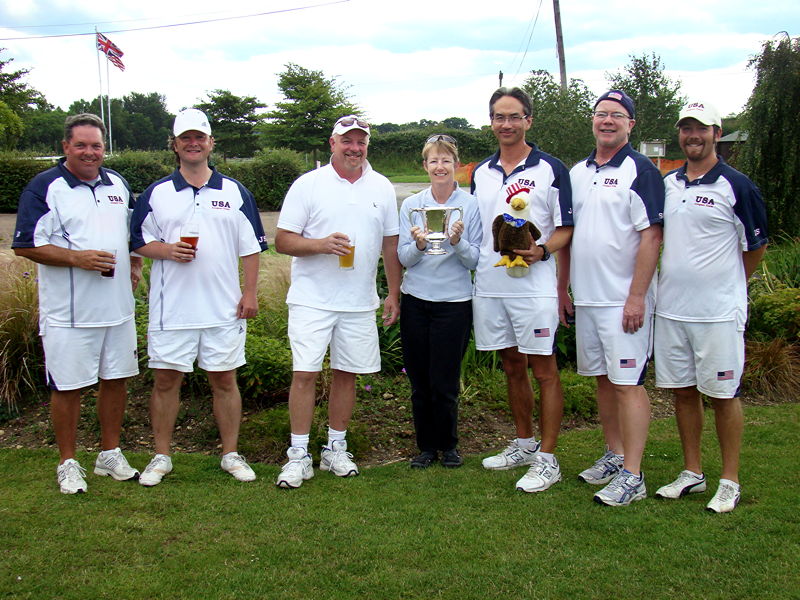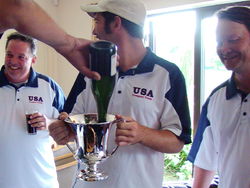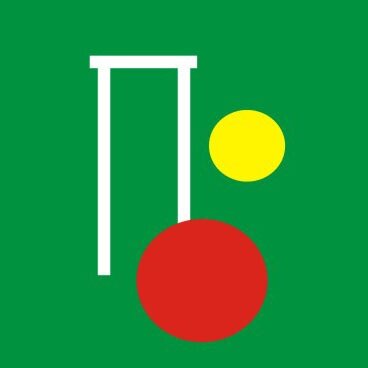 The winning team: Danny Huneycutt, Chris Patmore, Doug Grimsley, 'Team Mom' Eileen Soo, Jeff Soo, Jim Bast, Ben RothmanArticle by Jeff Soo | Photos by Eileen Soo | Gallery 1 | Gallery 2
The winning team: Danny Huneycutt, Chris Patmore, Doug Grimsley, 'Team Mom' Eileen Soo, Jeff Soo, Jim Bast, Ben RothmanArticle by Jeff Soo | Photos by Eileen Soo | Gallery 1 | Gallery 2
The United States beat Great Britain 13-8 at the 2011 Solomon Trophy, held June 28 – July 1 at the Hamptworth Golf & Country Club in Wiltshire, England. Having won the match for the first time ever in 2009 at Mission Hills, Team USA’s first Solomon win on British soil is also its first successful defense of the Trophy.
It is also the first association croquet loss for GB at home in twenty-five years, and their most lopsided defeat since 1979.
The match was in the usual format of teams of six playing a total of twenty-one matches — nine doubles and twelve singles. As in the 2009 test GB took a 2-1 lead in the first doubles round. And as in 2009 USA’s first point came from an exciting game 3 finish. USA Team Captain Danny Huneycutt had a three-ball break to win the match, but after a difficult penult hoop his ball ended next to the peg, leaving no shot at either ball. With a lift impending, he opted for the aggressive line and shot at the opponent’s forward ball on the the east boundary. He hit the roquet, and was complimented by the observing William Ormerod (a veteran of three winning GB MacRobertson Shield teams) for this “Captain’s shot”.
 Huneycutt on the winning turnThis was after 6 PM, the match having taken nine hours to finish, including a lunch break. The next doubles round started immediately and continued till dusk. USA players Jim Bast and Chris Patmore each finished triple peels to take 1-0 leads in their respective matches, a notable accomplishment on the difficult lawns. GB Team Captain Stephen Mulliner responded with a triple peel of his own to level his and Tony Le Moignan’s match against Patmore and Jeff Soo.
Huneycutt on the winning turnThis was after 6 PM, the match having taken nine hours to finish, including a lunch break. The next doubles round started immediately and continued till dusk. USA players Jim Bast and Chris Patmore each finished triple peels to take 1-0 leads in their respective matches, a notable accomplishment on the difficult lawns. GB Team Captain Stephen Mulliner responded with a triple peel of his own to level his and Tony Le Moignan’s match against Patmore and Jeff Soo.
Meanwhile Doug Grimsley outdid Huneycutt in making the most exciting finish of the day. His partner Ben Rothman had pegged out Ian Lines’s rover ball to leave a two-against-one endgame. Lines’s partner Samir Patel was for 4-back, and advanced his clip to the peg after some long hoops and hit-ins. Grimsley eventually started a rough three-ball break, but a long roll-up to 2-back left a severely angled shot, well over 45 degrees off line. Patel had a lift and a three-yard roquet to win, so Grimsley quickly stepped up and played a hard jump shot; to the amazement of his teammates he scored the hoop. The break never looked easy but he finished to take game 1 by +1, twelve hours after the start of play for the day.
Day 2 started with the first singles round. As a rule there is no double banking in test matches so the top two players from each team had a long wait. Normally one expects some matches to finish quickly, but the lawns were difficult enough that even the fastest matches continued till well after the lunch break. GB #3 Samir Patel beat USA #4 Doug Grimsley in two games to extend GB’s lead to 3-1. But shortly afterward USA #5 Jim Bast finished 2-0 against GB #6 Ian Burridge, and then USA #3 Chris Patmore beat GB #4 Tony Le Moignan 2-0 to level the score at 3-3. USA #6 Jeff Soo’s match against GB #5 Ian Lines finally finished nearly eleven hours after it started, Lines hitting his last lift to win +3 in the third game, giving GB the lead again at 4-3.
USA #1 Ben Rothman and GB #2 David Maugham adjourned their match at 1-all at around 8 PM, while the two team captains, USA #2 Danny Huneycutt and GB #1 Stephen Mulliner, continued their match until 9:00, Huneycutt having won the first game. So GB led 4-3, but USA was leading in three unfinished matches and tied in the other two.
 Ian Burridge reacts to a missAfter two long days the players were certainly used to the conditions, but the lawns were mowed and rolled each day and continued to offer a severe challenge — fast pace requiring delicate touch, mild slopes magnified by the pace and punishing even small errors in break management or stroke execution, and hard ground keeping the hoops solid. One measure of the difficulty of conditions is the number of successful peeling turns. Day 1 saw five triple peels in twelve games. But the lawns were just that much faster for the rest of the test, and there were only two triples completed in the remaining thirty-four games. On Day 3 there were none at all.
Ian Burridge reacts to a missAfter two long days the players were certainly used to the conditions, but the lawns were mowed and rolled each day and continued to offer a severe challenge — fast pace requiring delicate touch, mild slopes magnified by the pace and punishing even small errors in break management or stroke execution, and hard ground keeping the hoops solid. One measure of the difficulty of conditions is the number of successful peeling turns. Day 1 saw five triple peels in twelve games. But the lawns were just that much faster for the rest of the test, and there were only two triples completed in the remaining thirty-four games. On Day 3 there were none at all.
That was not the only remarkable thing about Day 3: USA turned a 3-4 deficit to an 8-4 lead. They swept the third round of doubles, winning all three matches 2-0, then won two of the remaining matches from round 2 to go 5-0 on the day. GB avoided a complete washout by leveling the last doubles match 1-1. It was one of the most successful days in Team USA history.
An 8-4 lead is not unassailable. Indeed, at the 2010 MacRobertson Shield, USA went from 4-8 down on day 3 to 9-all on the final day. But to go from trailing 3-4 to leading 8-4 was a huge momentum shift for the US team, who appeared to improve each day. And for all their skill and experience, it has been many years since a GB team has known what it is like to come from behind on the final day of a test match.
With the match still behind schedule, double-banking was introduced to start all six matches in the final singles round at the start of the final day. After three hours of play GB had won the first game in four matches while USA led in the other two. Burridge was first to finish a match, beating Soo 2-0 in time for lunch, a first for this test match. An hour later Bast finished 2-0 against Lines to make it 9-5, but a few minutes later Maugham did likewise against Huneycutt, cutting USA’s lead to 9-6.
 Team USA members Danny Huneycutt, Ben Rothman, and Chris Patmore celebrateRothman produced one of the day’s pivotal turns. Having won the first game against Mulliner, he was leading 21-0 in the second when Mulliner hit the lift and went round to peg out Rothman’s rover ball, leaving balls in corners 1 and 2, with Rothman for 4-back. Rothman started from the ball in corner 1, sending it between 4-back and penult while approaching the ball in corner 2. After a nervy roquet on this ball he split it to rover while taking deep position at 4-back. His five-yard shot cleared the hoop, leaving a rush to penult, and he finished to put USA “on the hill” at 10-6.
Team USA members Danny Huneycutt, Ben Rothman, and Chris Patmore celebrateRothman produced one of the day’s pivotal turns. Having won the first game against Mulliner, he was leading 21-0 in the second when Mulliner hit the lift and went round to peg out Rothman’s rover ball, leaving balls in corners 1 and 2, with Rothman for 4-back. Rothman started from the ball in corner 1, sending it between 4-back and penult while approaching the ball in corner 2. After a nervy roquet on this ball he split it to rover while taking deep position at 4-back. His five-yard shot cleared the hoop, leaving a rush to penult, and he finished to put USA “on the hill” at 10-6.
The two team captains then met to resume their first-round singles match, pegged down in game two. Mulliner missed his lift shot, and Huneycutt went round and pegged out Mulliner’s rover ball, each player’s backward ball for 4-back. Mulliner hit but failed 4-back to unrunnable and wired position, giving Huneycutt a free shot at partner. He hit and finished to win game, match, and test match, 11-6 to USA.
With the British Open starting at Surbiton the next day, and no certainty of finishing before dark, the captains agreed to halve the remaining matches — each tied at 1-1 — for an official final score of 13-8.
The win in 2009 was a milestone for Team USA, but some post-match commentary downplayed the win in light of the conditions: an away match for GB, in their off-season, lacking some of their strongest players, and played on typical American-style lawns — flat, easy-paced, and with forgiving hoops. The 2011 win is a convincing counter-argument. Commenting from afar, GB team veteran Chris Clarke wrote:
Many congrats to the US team. This win is at least 4 four times more impressive than their last. GB were mid-season, playing on lawns that should have suited them better and had a stronger team. If you read the commentary, it looks as if the US were stronger on every day and that the final score could easily have been 4-13. Jerry will be looking down with a big grin.
“Jerry” is Jerry Stark of course, Team USA stalwart until his untimely death from cancer in 2010. His goal, shared by all Team USA players and supporters, was to win the MacRobertson Shield. The next contest for the Shield will be early 2014 at Christchurch, legendary for testing conditions. With the win over GB at Hamptworth, Team USA has shown that it is finally learning to cope with such conditions.
